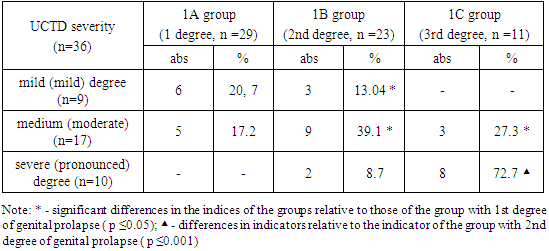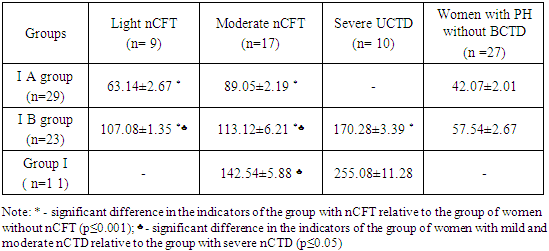-
Paper Information
- Next Paper
- Previous Paper
- Paper Submission
-
Journal Information
- About This Journal
- Editorial Board
- Current Issue
- Archive
- Author Guidelines
- Contact Us
American Journal of Medicine and Medical Sciences
p-ISSN: 2165-901X e-ISSN: 2165-9036
2023; 13(3): 290-293
doi:10.5923/j.ajmms.20231303.20
Received: Feb. 9, 2023; Accepted: Mar. 8, 2023; Published: Mar. 15, 2023

The Level of Oxyproline in the Urine in Women of Reproductive Age with Genital Prolapse and to Determine Their Relationship with the Severity of the Disease
Urinova Rozagul, Saidjalilova Dilnoza
Tashkent Medical Academy, street Farobiy 2, Tashkent, Uzbekistan
Correspondence to: Urinova Rozagul, Tashkent Medical Academy, street Farobiy 2, Tashkent, Uzbekistan.
| Email: |  |
Copyright © 2023 The Author(s). Published by Scientific & Academic Publishing.
This work is licensed under the Creative Commons Attribution International License (CC BY).
http://creativecommons.org/licenses/by/4.0/

The article studies and evaluates the level of oxyproline in the daily urine of women with genital prolapse against the background of undifferentiated connective tissue dysplasia, which makes it possible to judge the state of collagen metabolism in diseases accompanied by destructive processes in the connective tissue. In women with genital prolapse, 57.1% had undifferentiated connective tissue dysplasia. Purpose of the study: to study the level of hydroxyproline in the urine of women of reproductive age with genital prolapse and to determine their relationship with the severity of the disease. Material and research methods. 83 women of reproductive age were examined, of which 63 women had genital prolapse (main group). The remaining 20 women without genital prolapse formed the comparison group. According to the severity of genital prolapse ( according to the POP-Q classification), the main group was divided into 3 subgroups: 1 A subgroup consisted of 29 women with grade I prolapse; 1 The subgroup consisted of 23 women with II degree of genital prolapse and 1 C subgroup consisted of 11 women with severe degree. Research results. We conducted a clinical and anamnestic analysis, including somatic, gynecological and reproductive pathology of women, as well as the current condition and complaints. The average age of women in the main group was 26.4 ± 2.2 years, in the comparison group - 24.5 ± 0.6 years, which was in an unreliably significant range. Conclusions: We found that UCTD determines the features of the development of pelvic floor pathology and affects the formation of genital prolapse. Understanding the characteristics of connective tissue metabolism, namely, an increase in the level of hydroxyproline in the urine, and early detection of its violations can form the basis for preventing the formation and progression of genital prolapse in reproductive age.
Keywords: Connective tissue dysplasia, Daily urine, Genital prolapse, Oxyproline level
Cite this paper: Urinova Rozagul, Saidjalilova Dilnoza, The Level of Oxyproline in the Urine in Women of Reproductive Age with Genital Prolapse and to Determine Their Relationship with the Severity of the Disease, American Journal of Medicine and Medical Sciences, Vol. 13 No. 3, 2023, pp. 290-293. doi: 10.5923/j.ajmms.20231303.20.
Article Outline
1. Relevance
- Genital prolapse is the most common pathology of the pelvic floor in women [2,3,6,7], the share of which reaches about 25-38% among all gynecological diseases [7]. In recent years, there has been a worldwide trend towards an increase in the number of patients of reproductive age with a clinical picture of pelvic floor muscle failure, which brings this problem to another level - social. Thus, genital prolapse in women under the age of 45 is 30-38%, of which women under 30 make up 10.1%. At the same time, 2-12% of young women have severe prolapse [5].There is an inseparable interaction of the muscles of the perineum (especially the muscles that lift the anus and close the genital gap), providing the necessary tone to the pelvic floor and the stability of the connective tissue supporting system and some of its stretching only under tension. In violation of the integrity of the muscular-fascial structures of the pelvic floor, there is a decrease in contractility and a violation of neuro-reflex conduction. In the future, their atrophy and inability to maintain the normal position of the internal genital organs occurs. Under the influence of internal cystic and rectal pressure, the decrease in the tone of the muscles of the pelvic floor progresses, and the pelvic organs gradually descend. According to some authors, neuropathy n. pudendus, myopathy m. levator ani and connective tissue degeneration are the three main determinants of pelvic distancing [8].IN Recently, there have been increasing reports of genital prolapse in young women after vaginal delivery, even after caesarean section and in nulliparous women. These facts suggest that, first of all, pathological changes in the connective tissue, and only then childbirth and obstetric trauma of the pelvic floor contribute to the occurrence of pelvic organ prolapse in young women.It has now been proven that the cause of the development of genital prolapse in young women in most cases is hereditary diseases of the connective tissue [4,6]. Magnesium ions play an important role in maintaining the integrity of the connective tissue structure, which are necessary for the normal course of many physiological processes in the body. In this regard, it is of interest to determine the characteristics of the level of magnesium ions in the blood with varying degrees of severity of genital prolapse, since the literature describes the adverse effect of deficiency of this element in the peripheral blood on the development of obstetric and gynecological pathology and the structure of connective tissue. The theory of systemic connective tissue dysplasia (CTD) as the leading cause of prolapse is gaining ground. At the same time, childbirth and trauma are considered as provoking factors against the background of common undifferentiated forms of CTD. Prolapse of the genital organs in women of reproductive age after a single physiological birth and with a preserved hormonal background in the absence of factors contributing to an increase in intra-abdominal pressure is a common manifestation of generalized CTD. The more severe the manifestations of CTD, the more pronounced are the forms of the distance of the genital and pelvic organs.At present, the theory of systemic connective tissue dysplasia as the leading cause of prolapses has become widespread. UCTD is an anomaly of the tissue structure and is a systemic pathology, it would be logical to assume that the pelvic floor muscles cannot but respond to it with their characteristics. T.Yu. Smolnova et al. [4,5] believe that the prolapse and complete prolapse of the internal genital organs in women is one of the manifestations of undifferentiated connective tissue dysplasia at the level of the reproductive organs. Oxyproline is one of the main amino acids in collagen. The need for a biochemical study of the metabolism of the structural components of the connective tissue as an assessment of the state of the pelvic floor muscles is obvious. All this became the subject of our research.
2. Purpose of the Study
- To study the level of hydroxyproline in the urine of women of reproductive age with genital prolapse and to determine their relationship with the severity of the disease.
3. Material and Research Methods
- 83 women of reproductive age were examined, of which 63 women had genital prolapse (main group). The remaining 20 women without genital prolapse formed the comparison group. According to the severity of genital prolapse ( according to the POP-Q classification), the main group was divided into 3 subgroups: 1 A subgroup consisted of 29 women with grade I prolapse; 1 The subgroup consisted of 23 women with II degree of genital prolapse and 1 C subgroup consisted of 11 women with severe degree.The inclusion criteria for the group were: POP-Q 1-3 degree prolapse of the genitals, preserved menstrual function, the absence of diseases that increase intra-abdominal pressure and are accompanied by chronic cough, and the absence of surgical intervention on the genitals.The exclusion criteria from the group were: the presence of chronic pathologies that increase intra-abdominal pressure, a history of operations on the genital organs, including hysterectomy, hysterectomy, Manchester operation, etc. Recruitment into groups was carried out by "case - control".In the groups, an anamnesis was taken, a physical examination was performed, and the leading clinical syndromes of uCTD were identified. Methods for diagnosing UCTD included registration of phenotypic stigmas, determination of the magnesium level in the blood serum and the level of hydroxyproline in the daily urine. The significance of the difference in quantitative data with a normal distribution was carried out using Student's t-test for independent samples, the arithmetic mean and standard deviation M (SD) were calculated. To assess differences, the critical level of significance was p<0.05.
4. Research Results
- We conducted a clinical and anamnestic analysis, including somatic, gynecological and reproductive pathology of women, as well as the current condition and complaints. The average age of women in the main group was 26.4 ± 2.2 years, in the comparison group - 24.5 ± 0.6 years, which was in an unreliably significant range.The presence of UCTD in the studied women was determined by identifying 8 or more signs of undifferentiated connective tissue dysplasia out of 16 highly informative markers [1]. These include: joint hypermobility, thin skin, dentine defects, asthenic syndrome, mitral valve prolapse, lower limb varicose veins, arachnodactyly, skin hyperextensibility, gothic palate, striae, scoliosis, neurocirculatory dystonia, deviated septum, systolic murmur on cardiac auscultation due to small anomalies in the development of the heart, congenital dislocation of the hip, keloid scars. The severity of connective tissue dysplasia was assessed according to the scale of clinical criteria for the severity of UCTD.Thus, in the main group of women with genital prolapse, uCTD was detected in 36 women, which amounted to 57.1%. Whereas, in the group of women without genital prolapse, this indicator was 8.7%, which is 6.6 times less than in the group with genital prolapse. UCTD in 2 women without genital prolapse was observed in mild mild severity.When studying the severity of UCTD in groups of women with genital prolapse, interesting data were obtained (Table 1). As can be seen from Table 1, in the group of women with a mild degree of genital prolapse, uCTD occurred in 37.9% and was represented in almost equal amounts by mild (20.7%) and moderate (17.2%) degrees. There were no women with severe UCTD in this group.
|
|
5. Conclusions
- 1. We found that UCTD determines the features of the development of pelvic floor pathology and affects the formation of genital prolapse.2. Understanding the features of connective tissue metabolism, namely, an increase in the level of hydroxyproline in the urine, and early detection of its disorders can form the basis for preventing the formation and progression of genital prolapse in reproductive age.
 Abstract
Abstract Reference
Reference Full-Text PDF
Full-Text PDF Full-text HTML
Full-text HTML
